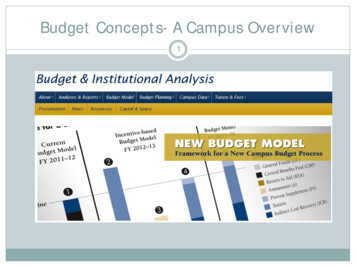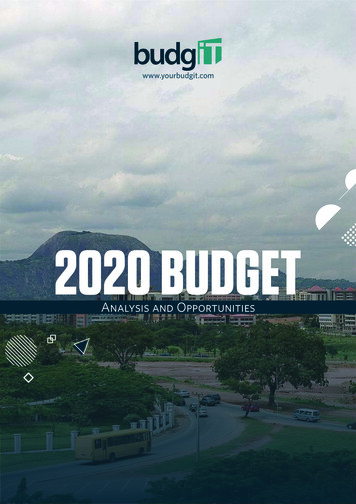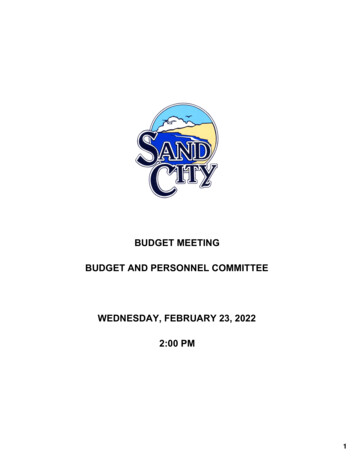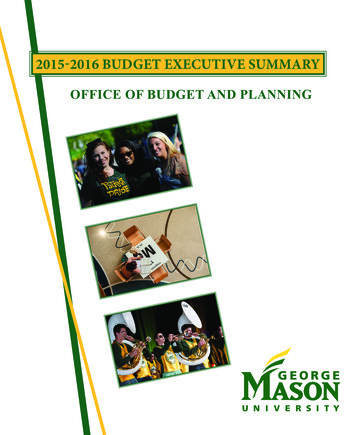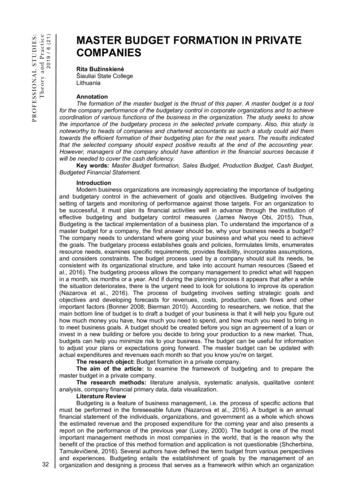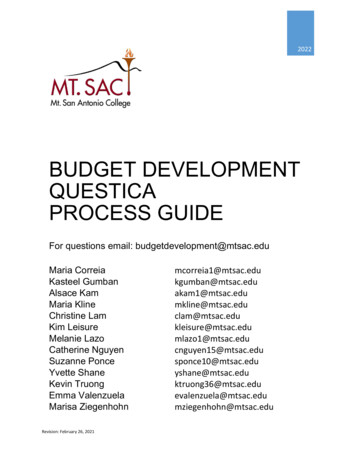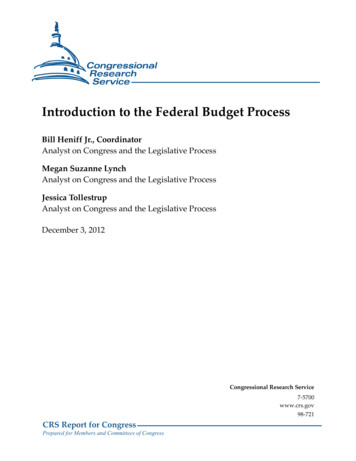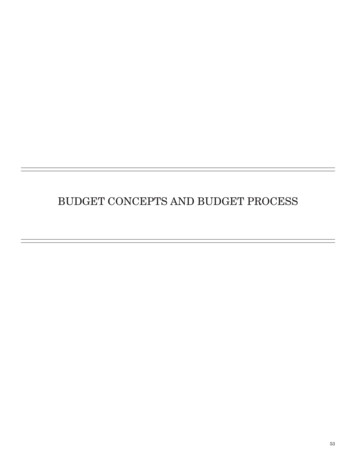
Transcription
BUDGET CONCEPTS AND BUDGET PROCESS53
6. BUDGET CONCEPTSThe budget system of the United States Governmentprovides the means for the President and the Congressto decide how much money to spend, what to spend iton, and how to raise the money they have decided tospend. Through the budget system, they determine theallocation of resources among the agencies of the FederalGovernment and between the Federal Government andthe private sector. The budget system focuses primarily on dollars, but it also allocates other resources, suchas Federal employment. The decisions made in the budget process affect the Nation as a whole, State and localgovernments, and individual Americans. Many budgetdecisions have worldwide significance. The Congress andthe President enact budget decisions into law. The budgetsystem ensures that these laws are carried out.This chapter provides an overview of the budget systemand explains some of the more important budget concepts.It includes summary dollar amounts to illustrate majorconcepts, and enumerates specific policies or presentationchoices in the 2022 Budget associated with some of theseconcepts. Other chapters of the budget documents dis-cuss these concepts and more detailed amounts in greaterdepth.The following section discusses the budget process, covering formulation of the President’s Budget, action by theCongress, budget enforcement, and execution of enactedbudget laws. The next section provides information onbudget coverage, including a discussion of on-budget andoff-budget amounts, functional classification, presentation of budget data, types of funds, and full-cost budgeting.Subsequent sections discuss the concepts of receipts andcollections, budget authority, and outlays. These sectionsare followed by discussions of Federal credit; surpluses,deficits, and means of financing; Federal employment;and the basis for the budget figures. A glossary of budgetterms appears at the end of the chapter.Various laws, enacted to carry out requirements of theConstitution, govern the budget system. The chapter refers to the principal ones by title throughout the text andgives complete citations in the section just preceding theglossary.THE BUDGET PROCESSThe budget process has three main phases, each ofwhich is related to the others:1. Formulation of the President’s Budget;2. Action by the Congress; and3. Execution of enacted budget laws.Formulation of the President’s BudgetThe Budget of the United States Government consistsof several volumes that set forth the President’s fiscalpolicy goals and priorities for the allocation of resourcesby the Government. The primary focus of the Budget ison the budget year—the next fiscal year for which theCongress needs to make appropriations, in this case 2022.(Fiscal year 2022 will begin on October 1, 2021, and endon September 30, 2022.) The Budget also covers the nineyears following the budget year in order to reflect the effectof budget decisions over the longer term. It includes thefunding levels provided for the current year, in this case2021, which allows the reader to compare the President’sBudget proposals with the most recently enacted levels.The Budget also includes data on the most recently completed fiscal year, in this case 2020, so that the reader cancompare budget estimates to actual accounting data.In a normal year (excluding transitions betweenAdministrations), the President begins the process of formulating the budget by establishing general budget andfiscal policy guidelines, usually by late spring of each year.Based on these guidelines, the Office of Management andBudget (OMB) works with the Federal agencies to establish specific policy directions and planning levels to guidethe preparation of their budget requests.During the formulation of the budget, the President,the Director of OMB, and other officials in the ExecutiveOffice of the President continually exchange information,proposals, and evaluations bearing on policy decisionswith the Secretaries of the Departments and the headsof the other Government agencies. Decisions reflectedin previously enacted budgets, including the one for thefiscal year in progress, reactions to the last proposed budget (which the Congress is considering at the same timethe process of preparing the forthcoming budget begins),and evaluations of program performance all influencedecisions concerning the forthcoming budget, as do projections of the economic outlook, prepared jointly by theCouncil of Economic Advisers, OMB, and the Departmentof the Treasury.Agencies normally submit their budget requests toOMB, where analysts review them and identify issuesthat OMB officials need to discuss with the agencies.OMB and the agencies resolve many issues themselves.Others require the involvement of White House policy officials and the President. This decision-making process55
56ANALYTICAL PERSPECTIVESis usually completed by late December. At that time, thefinal stage of developing detailed budget data and thepreparation of the budget documents begins.The decision-makers must consider the effects of economic and technical assumptions on the budget estimates.Interest rates, economic growth, the rate of inflation, theunemployment rate, and the number of people eligiblefor various benefit programs, among other factors, affectGovernment spending and receipts. Small changes inthese assumptions can alter budget estimates by manybillions of dollars. (Chapter 2, “Economic Assumptions andOverview,’’ provides more information on this subject.)Thus, the budget formulation process involves thesimultaneous consideration of the resource needs of individual programs, the allocation of resources among theagencies and functions of the Federal Government, andthe total outlays and receipts that are appropriate in lightof current and prospective economic conditions.The law governing the President’s Budget requiresthe transmittal of the following fiscal year’s Budget tothe Congress on or after the first Monday in Januarybut not later than the first Monday in February of eachyear. The budget is usually scheduled for transmission tothe Congress on the first Monday in February, giving theCongress eight months to act on the budget before the fiscal year begins. In years when a Presidential transitionhas taken place, this timeline for budget release is commonly extended to allow the new administration sufficienttime to take office and formulate its budget policy. Whilethere is no specific timeline set for this circumstance, thedetailed budget is usually completed and released in Aprilor May. However, in order to aid the congressional budget process (discussed below), new administrations oftenrelease a budget blueprint that contains broad spendingoutlines and descriptions of major policies and prioritiesearlier in the year.Congressional Action1The Congress considers the President’s Budget proposals and approves, modifies, or disapproves them. Itcan change funding levels, eliminate programs, or addprograms not requested by the President. It can add oreliminate taxes and other sources of receipts or makeother changes that affect the amount of receipts collected.The Congress does not enact a budget as such. Throughthe process of adopting a planning document called a budget resolution, the Congress agrees on targets for totalspending and receipts, the size of the deficit or surplus,and the debt limit. The budget resolution provides theframework within which individual congressional committees prepare appropriations bills and other spendingand receipts legislation. The Congress provides fundingfor specified purposes in appropriations acts each year. It1 For a fuller discussion of the congressional budget process, see BillHeniff Jr., Introduction to the Federal Budget Process (CongressionalResearch Service Report 98–721), and Robert Keith and Allen Schick,Manual on the Federal Budget Process (Congressional Research ServiceReport 98–720, archived).also enacts changes each year in other laws that affectspending and receipts.In making appropriations, the Congress does not voteon the level of outlays (spending) directly, but rather onbudget authority, which is the authority provided by lawto incur financial obligations that will result in outlays.In a separate process, prior to making appropriations, theCongress usually enacts legislation that authorizes anagency to carry out particular programs, authorizes theappropriation of funds to carry out those programs, and,in some cases, limits the amount that can be appropriated for the programs. Some authorizing legislation expiresafter one year, some expires after a specified number ofyears, and some is permanent. The Congress may enactappropriations for a program even though there is no specific authorization for it or its authorization has expired.The Congress begins its work on its budget resolutionshortly after it receives the President’s Budget. Under theprocedures established by the Congressional Budget Actof 1974 (Congressional Budget Act), the Congress decideson budget targets before commencing action on individualappropriations. The Act requires each standing committeeof the House and Senate to recommend budget levels andreport legislative plans concerning matters within thecommittee’s jurisdiction to the Budget Committee in eachbody. The House and Senate Budget Committees theneach design and report, and each body then considers,a concurrent resolution on the budget. The congressional timetable calls for the House and Senate to resolvedifferences between their respective versions of the congressional budget resolution and adopt a single budgetresolution by April 15 of each year.In the report on the budget resolution, the BudgetCommittees allocate the total on-budget budget authority and outlays set forth in the resolution to theAppropriations Committees and the other committeesthat have jurisdiction over spending. These committee allocations are commonly known as “302(a)” allocations, inreference to the section of the Congressional Budget Actthat provides for them. The Appropriations Committeesare then required to divide their 302(a) allocations of budget authority and outlays among their subcommittees.These subcommittee allocations are known as “302(b)” allocations. There are procedural hurdles associated withconsidering appropriations bills that would breach anAppropriations subcommittee’s 302(b) allocation. Similarprocedural hurdles exist for considering legislation thatwould cause the 302(a) allocation for any committee tobe breached. The Budget Committees’ reports may discuss assumptions about the level of funding for majorprograms. While these assumptions do not bind the othercommittees and subcommittees, they may influence theirdecisions.Budget resolutions may include “reserve funds,” whichpermit adjustment of the resolution allocations as necessary to accommodate legislation addressing specificmatters, such as healthcare or tax reform. Reserve fundsare most often limited to legislation that is deficit neutral,including increases in some areas offset by decreases in
576. Budget Concepts others. The budget resolution may also contain “reconciliation directives” (discussed further below).Since the concurrent resolution on the budget is not alaw, it does not require the President’s approval. However,the Congress considers the President’s views in preparing budget resolutions, because legislation developed tomeet congressional budget allocations does require thePresident’s approval. In some years, the President andthe joint leadership of Congress have formally agreed onplans to reduce the deficit or balance the budget. Theseagreements were then reflected in the budget resolutionand legislation passed for those years.If the Congress does not pass a budget resolution, theHouse and Senate typically adopt one or more “deemingresolutions” in the form of a simple resolution or as a provision of a larger bill. A deeming resolution may servenearly all functions of a budget resolution, except it maynot trigger reconciliation procedures in the Senate.Once the Congress approves the budget resolution, itturns its attention to enacting appropriations bills andauthorizing legislation. The Appropriations Committeein each body has jurisdiction over annual appropriations.These committees are divided into subcommittees thathold hearings and review detailed budget justificationmaterials prepared by the Executive Branch agencieswithin the subcommittee’s jurisdiction. After a bill hasbeen drafted by a subcommittee, the full committee andthe whole House, in turn, must approve the bill, sometimeswith amendments to the original version. The House thenforwards the bill to the Senate, where a similar reviewfollows. If the Senate disagrees with the House on particular matters in the bill, which is often the case, the twobodies form a conference committee (consisting of someMembers of each body) to resolve the differences. The conference committee revises the bill and returns it to bothbodies for approval. When the revised bill is agreed to,first in the House and then in the Senate, the Congresssends it to the President for approval or veto.Since 1977, when the start of the fiscal year was established as October 1, there have been only three fiscal years(1989, 1995, and 1997) for which the Congress agreed toand enacted every regular appropriations bill by that date.When one or more appropriations bills are not enacted bythis date, the Congress usually enacts a joint resolutioncalled a “continuing resolution’’ (CR), which is an interimor stop-gap appropriations bill that provides authorityfor the affected agencies to continue operations at somespecified level until a specific date or until the regular appropriations are enacted. Occasionally, a CR has funded aportion or all of the Government for the entire year.The Congress must present these CRs to the Presidentfor approval or veto. In some cases, Congresses have failedto pass a CR or Presidents have rejected CRs becausethey contained unacceptable provisions. Left withoutfunds, Government agencies were required by law to shutdown operations—with exceptions for some limited activities—until the Congress passed a CR the President wouldapprove. Shutdowns have lasted for periods of a day toseveral weeks.The Congress also provides budget authority in lawsother than appropriations acts. In fact, while annual appropriations acts fund the majority of Federal programs,they account for only about a third of the total spending in a typical year. Authorizing legislation controls therest of the spending, which is commonly called “mandatory spending.” A distinctive feature of these authorizinglaws is that they provide agencies with the authority orrequirement to spend money without first requiring theAppropriations Committees to enact funding. This category of spending includes interest the Government payson the public debt and the spending of several majorprograms, such as Social Security, Medicare, Medicaid, unemployment insurance, and Federal employee retirement.Almost all taxes and most other receipts also result fromauthorizing laws. Article I, Section 7 of the Constitutionprovides that all bills for raising revenue shall originatein the House of Representatives. In the House, the Waysand Means Committee initiates tax bills; in the Senate,the Finance Committee has jurisdiction over tax laws.BUDGET CALENDARThe following timetable highlights the scheduled dates for significant budget events during a normal budget year:Between the 1st Monday in January and the1st Monday in February President transmits the budgetSix weeks later. Congressional committees report budget estimates to Budget CommitteesApril 15. Action to be completed on congressional budget resolutionMay 15. House consideration of annual appropriations bills may begin even if the budget resolution hasnot been agreed to.June 10. House Appropriations Committee to report the last of its annual appropriations bills.June 15. Action to be completed on “reconciliation bill” by the Congress.June 30. Action on appropriations to be completed by HouseJuly 15. President transmits Mid-Session Review of the BudgetOctober 1. Fiscal year begins
58ANALYTICAL PERSPECTIVESThe budget resolution often includes reconciliationdirectives, which require authorizing committees torecommend changes in laws that affect receipts or mandatory spending. They direct each designated committeeto report amendments to the laws under the committee’sjurisdiction that would achieve changes in the levels ofreceipts or mandatory spending controlled by those laws.These directives specify the dollar amount of changes thateach designated committee is expected to achieve, but donot specify which laws are to be changed or the changes tobe made. However, the Budget Committees’ reports on thebudget resolution frequently discuss assumptions abouthow the laws would be changed. Like other assumptionsin the report, they do not bind the committees of jurisdiction but may influence their decisions. A reconciliationinstruction may also specify the total amount by whichthe statutory limit on the public debt is to be changed.The committees subject to reconciliation directivesdraft the implementing legislation. Such legislation may,for example, change the tax code, revise benefit formulasor eligibility requirements for benefit programs, or authorize Government agencies to charge fees to cover someof their costs. Reconciliation bills are typically omnibuslegislation, combining the legislation submitted by eachreconciled committee in a single act.The Senate considers such omnibus reconciliationacts under expedited procedures that limit total debateon the bill. To offset the procedural advantage gained byexpedited procedures, the Senate places significant restrictions on the substantive content of the reconciliationmeasure itself, as well as on amendments to the measure. Any material in the bill that is extraneous or thatcontains changes to the Federal Old-Age and SurvivorsInsurance and the Federal Disability Insurance programsis not in order under the Senate’s expedited reconciliationprocedures. Non-germane amendments are also prohibited. Reconciliation acts, together with appropriationsacts for the year, are usually used to implement broadagreements between the President and the Congress onthose occasions where the two branches have negotiateda comprehensive budget plan. Reconciliation acts havesometimes included other matters, such as laws providing the means for enforcing these agreements.Budget EnforcementThe Federal Government uses budget enforcementmechanisms to control revenues, spending, and deficits.The Statutory Pay-As-You-Go Act of 2010, enacted onFebruary 12, 2010, reestablished a statutory procedure toenforce a rule of deficit neutrality on new revenue andmandatory spending legislation. The Budget ControlAct of 2011 (BCA), enacted on August 2, 2011, amendedthe Balanced Budget and Emergency Deficit ControlAct of 1985 (BBEDCA) by reinstating limits (“caps”) onthe amount of discretionary budget authority that canbe provided through the annual appropriations process.The BCA also created a Joint Select Committee on DeficitReduction that was instructed to develop a bill to reducethe Federal deficit by at least 1.5 trillion over a 10-yearperiod, and imposed automatic spending cuts to achieve 1.2 trillion of deficit reduction over nine years afterthe Joint Committee process failed to achieve its deficitreduction goal. The original enforcement mechanisms established by the BCA—the caps on spending in annualappropriations and instructions to calculate reductions toachieve the 1.2 trillion deficit reduction goal—expire atthe end of fiscal year 2021, although the sequestration ofmandatory spending has been extended through 2030.BBEDCA divides spending into two types—discretionary spending and direct (or mandatory) spending.Discretionary spending is controlled through annualappropriations acts. Funding for salaries and other operating expenses of Government agencies, for example,is generally discretionary. Direct spending (also referredto as mandatory spending) is controlled by permanentlaws. Medicare and Medicaid payments, unemploymentinsurance benefits, and farm price supports are examplesof mandatory spending. Receipts are included under thesame statutory enforcement rules that apply to mandatory spending because permanent laws generally controlreceipts.Direct spending enforcement. The Statutory PayAs-You-Go Act of 2010 requires that new legislationchanging mandatory spending or revenue must be enacted on a “pay-as-you-go” (PAYGO) basis; that is, that thecumulative effects of such legislation must not increaseprojected on-budget deficits. PAYGO is a permanent requirement, and it does not impose a cap on spending ora floor on revenues. Instead, PAYGO requires that legislation reducing revenues must be fully offset by cuts inmandatory programs or by revenue increases, and thatany bills increasing mandatory spending must be fully offset by revenue increases or cuts in mandatory spending.This requirement of deficit neutrality is not enforced ona bill-by-bill basis, but is based on two scorecards that tally the cumulative budgetary effects of PAYGO legislationas averaged over rolling 5- and 10-year periods, startingwith the budget year. Any impacts of PAYGO legislationon the current year deficit are counted as budget year impacts when placed on the scorecard. PAYGO is enforced bysequestration. Within 14 business days after a congressional session ends, OMB issues an annual PAYGO report. Ifeither the 5- or 10-year scorecard shows net costs in thebudget year column, the President is required to issue a sequestration order implementing across-the-board cuts tononexempt mandatory programs by an amount sufficientto offset those net costs. The PAYGO effects of legislationmay be directed in legislation by reference to statementsinserted into the Congressional Record by the chairmen ofthe House and Senate Budget Committees. Any such estimates are determined by the Budget Committees and areinformed by, but not required to match, the cost estimatesprepared by the Congressional Budget Office (CBO). Ifthis procedure is not followed, then the PAYGO effectsof the legislation are determined by OMB. Provisions ofmandatory spending or receipts legislation that are designated in that legislation as an emergency requirementare not scored as PAYGO budgetary effects.
6. Budget Concepts The PAYGO rules apply to the outlays resulting fromoutyear changes in mandatory programs made in appropriations acts and to all revenue changes made inappropriations acts. However, outyear changes to mandatory programs as part of provisions that have zero netoutlay effects over the sum of the current year and thenext five fiscal years are not considered under the PAYGOrules.The PAYGO rules do not apply to increases in mandatory spending or decreases in receipts that resultautomatically under existing law. For example, mandatory spending for benefit programs, such as unemploymentinsurance, rises when the number of beneficiaries rises,and many benefit payments are automatically increasedfor inflation under existing laws.The House and Senate impose points of order againstconsideration of tax or mandatory spending legislationthat would violate the PAYGO principle, although thetime periods covered by these rules and the treatmentof previously enacted costs or savings may differ in somerespects from the requirements of the Statutory Pay-AsYou-Go Act of 2010.BBEDCA Section 251A reductions. The failure ofthe Joint Select Committee on Deficit Reduction to propose, and the Congress to enact, legislation to reducethe deficit by at least 1.5 trillion triggered automaticreductions to discretionary and mandatory spendingin fiscal years 2013 through 2021. The reductions wereimplemented through a combination of sequestration ofmandatory spending and reductions in the discretionary caps, with some modifications as provided for in theAmerican Taxpayer Relief Act of 2012, and the BipartisanBudget Acts (BBAs) of 2013, 2015, 2018, and 2019.By amending section 251A of BBEDCA, the mandatorysequestration provisions were extended beyond 2021 bythe BBA of 2013, which extended sequestration through2023; Public Law 113-82, commonly referred to as theMilitary Retired Pay Restoration Act, which extendedsequestration through 2024; the BBA of 2015, which extended sequestration through 2025; the BBA of 2018,which extended sequestration through 2027; the BBA of2019, which extended sequestration through 2029; andPublic Law 116-136, commonly referred to as the CARESAct, which extended sequestration through 2030.Starting in 2022, section 251A of BBEDCA requiresthat the same percentage reductions for non-exemptmandatory defense and non-defense spending will be applied each year at the rate established in 2021. Thosereductions are 5.7 percent for non-defense accounts, 8.3percent for defense accounts, and 2 percent for Medicareand community and migrant health centers. 2 Sincethe percentage reduction is known in advance, the 2022Budget will present these reductions at the account level.2 The CARES Act, as amended by Public Law 117-7, suspended theMedicare sequestration from May 1, 2020 to December 31, 2021 andspecified that, notwithstanding the 2 percent limit on Medicare sequestration in the BCA, the reduction in the Medicare program should be2 percent in the first 5.5 months of 2030, a 4 percent reduction in thesecond 6 months of 2030, and a 0 percent reduction in the remaininghalf month of 2030.59Previously, the Budget reflected the reductions starting inthe budget year in a central allowance account.Discretionary cap enforcement. BBEDCA specifiedspending limits (“caps”) on discretionary budget authorityfor 2012 through 2021. Similar enforcement mechanismswere established by the Budget Enforcement Act of 1990and were extended in 1993 and 1997, but expired at theend of 2002. The threat of sequestration if the caps werebreached proved sufficient to ensure compliance with thediscretionary spending limits.When caps were in place, BBEDCA required OMB toadjust the caps each year for: changes in concepts and definitions; appropriations designated by the Congress andthe President as emergency requirements; and appropriations designated by the Congress and the Presidentfor Overseas Contingency Operations/Global War onTerrorism (OCO/GWOT). BBEDCA also specified capadjustments (which are limited to fixed amounts) for:appropriations for continuing disability reviews and redeterminations by the Social Security Administration;the healthcare fraud and abuse control program at theDepartment of Health and Human Services; appropriations designated by the Congress as being for disasterrelief; appropriations for reemployment services and eligibility assessments; appropriations for wildfire suppressionat the Department of Agriculture and the Department ofthe Interior; and, for 2020 only, appropriations providedfor the 2020 Census at the Department of Commerce.The 2022 Budget does not propose new caps on discretionary funding. The caps in place from 2012 through2021, especially after Joint Committee enforcement wastriggered, led to a serious erosion in discretionary resources, particularly for non-defense funding, and contributedto a decade of under-investments in core public servicesand programs.However, the 2022 Budget does support retaining several of the aforementioned cap adjustments as “allocationadjustments” to be used pursuant to the CongressionalBudget Act in the Congressional Budget Resolution. TheBudget does not retain all the BBEDCA adjustments(specifically, the Administration shifts funds that hadbeen designated as OCO to the base) but it still providesfunds for anomalous or above-base activities such as program integrity, disaster relief, and wildfire suppressionthat continue to be presented outside of the base allocation for certain accounts. In anticipation of most of theseuseful mechanisms being retained as part of the annualbudget and appropriations process, the Budget includesthe following adjustments above the base level of discretionary funding: Program Integrity. This allocation adjustmentcontinues to recognize that certain discretionary activities focused on program integrity in the largestbenefit programs (Social Security, Medicare, Medicaid, and Unemployment Insurance) have a returnon investment (ROI) in the form of savings for theseprograms. The allocation adjustment, shown in the2022 Budget as an additional amount for programintegrity activities in the specific benefit program’sdiscretionary request, encourages the Congress to
60ANALYTICAL PERSPECTIVEScontinue proposing those adjustments and reapingthe savings associated with this activity. The Administration also supports additional program integrity funding through an allocation adjustmentto support ongoing enforcement of tax payments bythe Internal Revenue Service. Savings derived fromthe program integrity allocation adjustments on thediscretionary side are assumed to continue into theoutyears. Because the savings are only generated ifthe funding is provided in annual discretionary appropriations, savings in the mandatory benefit programs are shown as a legislative proposal not subject to Pay-As-You Go procedures. This allows thescorekeeping community to recognize the benefitsof
cuss these concepts and more detailed amounts in greater depth. The following section discusses the budget process, cov - ering formulation of the President's Budget, action by the

